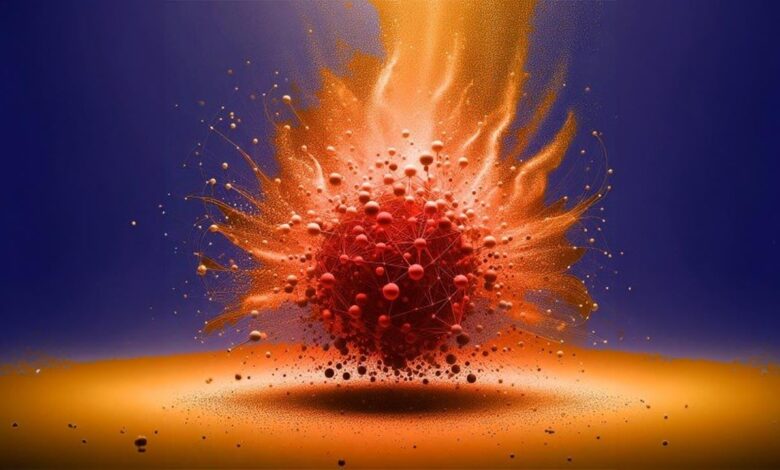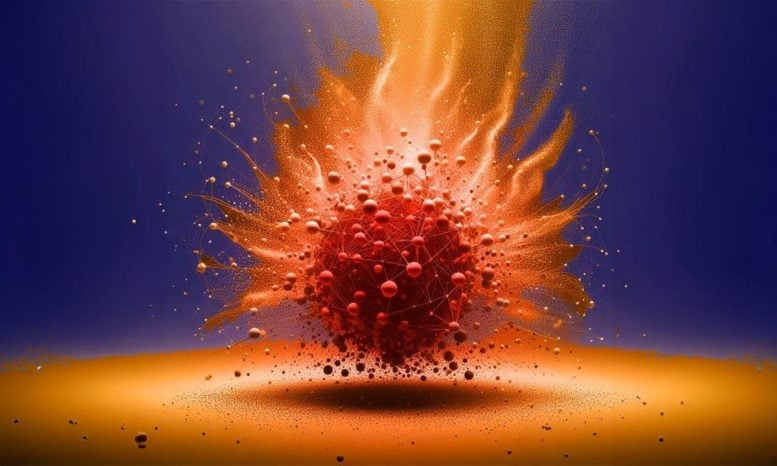Surprising Insights Into the Origins of Matter in the Early Universe

By

Artist’s depiction of the spray of particles arising from the collision of two heavy atoms. As the hot subatomic soup cools, newly formed particles shower off into space. Credit: Joseph Dominicus Lap, edited
Scientists have recreated the extreme conditions of the early universe in particle accelerators, revealing surprising insights about the formation of matter.
New calculations show that up to 70% of certain particles may originate from later reactions rather than the initial quark-gluon soup formed just after the Big Bang. This discovery challenges previous assumptions about the timeline of matter formation and suggests that much of the matter around us formed later than expected. By understanding these processes, scientists can better interpret the results of collider experiments and refine their knowledge of the universe’s origins.
Recreating the Early Universe’s Extreme Conditions
The early universe was 250,000 times hotter than the core of our sun. That’s far too hot to form the protons and neutrons that make up everyday matter. Scientists recreate the conditions of the early universe in particle accelerators by smashing atoms together at nearly the speed of light. Measuring the resulting shower of particles allows scientists to understand how matter formed.
The particles that scientists measure can form in various ways: from the original soup of quarks and gluons or from later reactions. These later reactions began 0.000001 seconds after the Big Bang, when the composite particles made of quarks began to interact with each other. A new calculation determined that as much as 70% of some measured particles are from these later reactions, not from reactions similar to those of the early universe.
Understanding the Origins of Matter
This finding improves scientific understanding of the origins of matter. It helps identify how much of the matter around us formed in the first few fractions of a second after the Big Bang, versus how much matter formed from later reactions as the universe expanded. This result implies large amounts of the matter around us formed later than expected.
To understand the results of collider experiments, scientists must discount the particles formed in the later reactions. Only those formed in the subatomic soup reveal the early conditions of the universe. This new calculation shows that the number of measured particles formed in reactions is much higher than expected.
Significance of Later Reactions in Particle Formation
In the 1990s, physicists realized that certain particles form in significant numbers from the later reactions following the initial formation phase of the universe. Particles called D mesons can interact to form a rare particle, charmonium. Scientists lacked consensus on how important the effect is. Since charmonium is rare, it is difficult to measure.
However, recent experiments provide data on how many charmonium and D mesons colliders produce. Physicists from Yale University and Duke University used the new data to calculate the strength of this effect. It turns out to be much more significant than expected. More than 70% of charmonium measured could be formed in reactions.
Implications for Understanding Matter’s Origins
As the hot soup of subatomic particles cools, it expands in a ball of fire. This all happens in less than one-hundredth of the time it takes for light to cross an atom. Since this is so fast, scientists are unsure exactly how the fireball expands.
The new calculation shows that scientists do not absolutely need to know the details of this expansion. The collisions produce a significant amount of charmonium regardless. The new result brings scientists one step closer to understanding the origins of matter.
Reference: “Hadronic J/ψ regeneration in Pb+Pb collisions” by Joseph Dominicus Lap and Berndt Müller, 11 October 2023, Physics Letters B.
DOI: 10.1016/j.physletb.2023.138246
This work was supported by the Department of Energy Office of Science, Nuclear Physics program. One of the researchers also acknowledges the hospitality and financial support provided during a sabbatical stay at Yale University.



